Glorious Pleiad of Russian admirals
Franz Yakovlevich Lefort
(1656 - 1699)- He was the first Russian admiral, nearest associate to Peter the Great. He was Swiss by birth. Since 1678 he was in Russian service. At the same time he had ranks of general-lieutenant and admiral and he often signed official papers with two ranks: general and admiral (but he was not general-admiral). He took part in Russian-Turkish War 1676-1681 Crimean Campaigns of 1687 and 1689. Together with F.A.Golovin and P.B.Voznitsyn he headed "Great Embassy". He participated in organizing of Russian regular army and fleet. He commanded Russian Navy in the Azov campaign 1696.
Fedor Alexeevich Golovin
(1650-1706) - The second admiral in Russian history. He had two ranks: general-Field-Marshal and admiral. He was Peter's associate. He took part in the Azov campaign of 1695-1696. He commanded the first Russian squadron in the Azov Sea. In 1699 having a rank of admiral he was at the head of Naval department, since 1700 he headed Navigation School.
Fedor Matveevich Apraksin
(1661-1728) - The first general-admiral in Russia. It was the highest rank in the fleet. According to the "Table of Ranks" he was equated with general-Field-Marshal by Peter the Great who gave him a rank of admiral. Apraksin was Peter's associate and one of the founders of Russian Fleet. In Gangut Battle (1714) he commanded the flotilla of row-ships. During the Persian campaign of 1722-1723 he commanded the Caspian flotilla. In 1723-1726 he was a Commander-in-Chief of the Baltic Fleet. Since 1726 he was a member of Supreme Privy Council as A.D. Menshikov's supporter.
Peter the Great
(1672-1725) - Since 1682 he had been Russian Tsar and since 1721 the first Russian Emperor. He was the founder of regular Army and Navy, Admiral. In the rank of shautbenaht (1709) he took part in the Gangut Battle but actually commanded an advance-guard of rowing flotilla. Because of that he was promoted to the rank of vice-admiral (1714).
Ivan Fedoseevich Botsis
(? - 1714) - He was a shautbenaht of the rowing fleet (1704). This rank was equal to rear-admiral of sailing fleet. Peter the Great valued him high for his competence and his private merits. Together with vice-admiral Cruis he was tsar's sponsor at Peter 's wedding with Ekaterina.
Kornely Ivanovich Cruis
(1657-1727) - He was an admiral. Being Norwegian by birth he was taken to Russian service in 1698 as vice-admiral. In 1705, an attack of Swedish fleet to Krondschtadt was repulsed under his command. In 1706-1713 he commanded the Russian fleet, commanded the St.Petersburg's defence during Swedish blockade of the city. Because of his inability to organize and cessation of pursuit of enemy he had been taken to court and was sentenced to death, but Peter forgave him and exiled him to Kazan instead. In 1715 he has been relieved of exile and appointed to a service in Admiralty-Board and since 1718 he was its vice-president.
Alexander Danilovich Menshikov
(1673-1729) - He was Generalissimo (1727), admiral, Peter's associate. During the North War 1700-1721 he was a prominent military leader. In 1716 he commanded the Baltic Fleet. In 1718-1724 and 1726-1727 he was a president of Military Board. In 1727 he was exiled by emperor Peter II to Beresov where he died.
Andrei Ivanovich Osterman
(1686-1747) - He was the second general-admiral in the history of Russian fleet. He was in Russian service since 1703. He showed persistence in realization of Peter's outlines and plans that saved Russian fleet many times. Having received rank of general-admiral he assumed in full administration of Naval Department. While not being a sailor by profession he took advises and directions of the best and most experienced Russian sailors such as F.A.Golovin.
Mikhail Mikhailovich Golitsyn
(1681-1764) - He was the third general-admiral in the Russian fleet's history. In the Grengam Battle he commanded the galley detachment of rowing fleet which won the victory over the Swedish sailing squadron. Since 1748 he was a Commander-in-Chief of Russian fleet. Since 1750 till 1761 he was a president of Admiralty-Board. (Since 1762 the rank of general-admiral was given only for honor and only to heirs of throne or to the members of tsar's family. After Golitsin emperor Pavel I, Grand Duke Konstantin Nikolaevich and Grand Duke Alexey Alexandrovich - the last general-admiral of Russian Fleet - had this rank).
Grigory Andreevich Spiridov
(1713-1790) - He was a naval commander, admiral. During Russian-Turkish War 1768-1774 he commanded (since 1769) the squadron in the Mediterranean Sea. He won the victory of Chesmen battle (1770). In 1771-1773 he commanded the Russian Fleet in Archipelago. He founded the basis for fleet tactics of maneuver.
Samuil Karlovich Graig
(1736-1788) - He was a naval commander, vice-admiral. He joined the Russian service in 1763, before that he served in English Fleet. Being a member of Spiridov's squadron he commanded a ship detachment in Chesmen Battle (1770). In 1774 he was appointed commander-in-Chief of Kronschtadt port. In Russian-Swedish War (1788-1790) he commanded Baltic Fleet and won the victory in the Gogland naval Battle (1788).
Nikolai Semenovich Mordvinov
(1754-1845) - He was a statesman and public figure, admiral. He was the first Naval Minister (1802). Having held this post only for three months he sent in his resignation because of his disagreement with a chairman of "Committee for putting Fleet in better conditions" count A.R.Vorontsov who negated the necessity of foundation the strong Navy.
Vasily Vasil'evich Chichagov
(1726-1809) - He was a navigator, polar explorer, admiral. During Russian-Swedish War 1788-1790 he was a commander of Baltic Fleet, he took part in the battles near Aland, Revel (Tallinn) and Vyborg. The islands on New Land Archipelago, an island in Alexander's archipelago (near the shores of North America), the bay and cape of the island Nauku-Hiva (South Polynesia) and a mountain at Shpitsbergen are named after Chichagov.
Pavel Vasil'evich Chichagov
(1767-1817) - He was an admiral who replaced Mordvinov on the post of Naval Minister. He realized reconstruction of St.Petersburg's Admiralty by employing an architect of Naval Department A.D.Zakharon for this work. During the Patriotic War of 1812 he commanded the army that acted opposit the South flank of Napoleon's forces. In 1811 he handed over the post of Naval Ministry to admiral marquis de Traverse under which command squadron had never been put to sea farther than Kronschtadt. And so the part of Finnish Bay near the Neva's estuary was ironically named "Marquis's puddle".
Fedor Fedorovich Ushakov
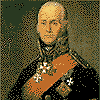
(1744-1817) - He was a naval commander, an admiral, one of the founders of Black Sea Fleet and its commander (1790-1800). He was a founder of sailing fleet manoeuvre tactics. He gained a series of significant victories over Turkish Fleet in the Kerch naval battle near Tendra (1790) and Kaliakria (1791). He carried on the Mediterranean Sea Campaign for Russian Fleet successfully during the war against France 1798-1800.
Gavriil Andreevich Sarychev
(1763-1831) - He was the first general-hydrographer in Russian fleet history, he was the honorary member of St.Petersburg Academy of Sciences, admiral. Since 1808 he was at the head of hydrographical researches in Russia.
Dmitri Nikolaevich Sinyavin
(1763-1831) - He was a naval commander, admiral. During the Russian-Turkish War (1806-1812) he commanded a squadron in the Adriatic and Aegean Seas (1806-1807). He routed Turkish Fleet in Dardanel and Afon battles (1807). Since 1825 he was a Commander-in-Chief of Baltic Fleet.
Vasily Mikhailovich Golovin
(1776-1831) - He was a navigator, a Corresponding Member of St.Petersburg Academy of Sciences, a vice-admiral. He directed world cruises on the ships "Diana" (1807-1809) and "Kamchatka" (1817-1819). On the Kurile isles, having been taken prisoner by the Japanese, he was in captivity (1811-1813). Since 1823 during his 8-year being a quartermaster-general of Fleet there were built more than 200 ships including first 10 steamships.
Faddei Faddeevich Bellinsgauzen

(1778-1852) - He was a navigator who discovered Antarctic Continent (1821), an admiral. In (1828-1829) in the rank of rear-admiral he took part in Russian-Turkish War commanding detachment. Since 1839 he was a military governor of Kronschtadt where the his monument was put up in 1870 (by I.N.Shreder).
Ivan Fedorovich Kruzenshtern
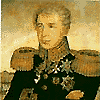
(1770-1846) - He was a navigator, a Corresponding Member (1803) and the honorary Member of St.Petersburg Academy of Science, an admiral. He was a founder of oceanography, the head of the first expedition around the world (1803-1806) on the ship "Nadezda" (commander I.F.Bellinsgauzen) and "Neva" (commander U.F.Lisyansky). In 1827-1842 he was a headmaster of the Naval Military School.
Mikhail Petrovich Lazarev
(1788-1851) - He was a naval commander, a navigator, an admiral. In 1813-1825 he sailed three times round the world including expedition of F.F.Bellinsgauzen where he was a commander of ship "Mirny". When crushing Turks in Navar Battle (1827) he commanded the battleship "Azov". In 1833-1850 he was Commander-in-Chief of Baltic Fleet and Black Sea Ports.
Vladimir Alexeevich Kornilov
(1806-1854) - He was a vice-admiral. Since 1849 he was a head of naval staff, since 1851 he practically commanded Black Sea Fleet. During the Crimea War (1853-1856) he directed the battle preparations for Sevastopol defence from the land. During the first bombardment of the town he was killed.
Fedor Petrovich Litke
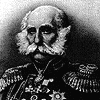
(1797-1882) - He was a navigator and geographer, an explorer of Arctic, a chairman of Naval Scientific Committee (since 1846) and admiral, Corresponding Member (1829), the honorary Member (1855) and a president (1864-1882) of St.Petersburg Academy of Science. He was one of the founders of Russian geographic society which instituted the Golden Medal named after Litke in 1873. All outstanding geographer-investigators are being awarded this medal up to the moment.
Pavel Stepanovich Nakhimov
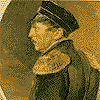
(1802-1855) - He was a naval commander, an admiral (1855). He was an associate to M.P.Lazarev. He took part in Navarin battle (1827) in which Russian squadron was commanded by rear-admiral L.P.Heiden. There were lieutenant P.S.Nakhimov, midshipman V.A.Kornilov, naval cadet V.I.Istomin at the list of distinguished on the battleship "Azov". During the Crimea War he commanded the squadron of Black Sea Fleet that routed Turkish squadron in Sinop Battle (1853). He successfully commanded the defence of Sevastopol (1854-1855). He was mortally wounded in the action.
Vladimir Ivanovich Istomin
(1809-1855) - He was a rear-admiral. During Sinop Battle he commanded the battleship "Paris". During the defence of Sevastopol he directed the defence of Malakhov Barrow.
Gennady Ivanovich Nevelsky
(1813-1876) - He was an explorer of the Far East, admiral. In 1848-1849 and 1850-1855 he was exploring Sakhalin (he proved that it is an island), the Lower Amur, the Tatar Strait. He founded the post Nikolaevsk (1850), now it's Nikolaevsk-on-Amur.
Alexei Ivanovich Butackov
(1816-1869) - He was an explorer of the Aral Sea, hydro-geographer, a rear-admiral. This was he who founded the Aral Flotilla. He made the first exact chart of the Aral Sea.
Gregory Ivanovich Butackov
(1820-1882) - He was an admiral, the creator of steam-fleet tactics. During the Crimea War he distinguished himself in the defence of the Malakhov Barrow. In 1867-1877 he commanded the squadron of iron-clads on the Baltic Fleet. In 1881 he was a commander of St.Petersburg Port.
Alexander Fedorovich Mozhaisky
(1825-1890) - He was a rear-admiral, an inventor in the sphere of aeronautics. He served in the Baltic Fleet in 1841-1861 and in 1879-1882. In 1881 he got the privilege on the "aeronautic missile" invented by him. The tests of the model were carried out in Krasnoye Selo in the suburb of St.Petersburg.
Stepan Osipovich Makarov
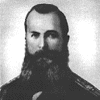
(1848-1904) - He was a naval commander, an oceanographer, a vice-admiral. He worked out tactics for ironclad fleet, investigated the problems of ship insinking and vitality. At the beginning of Russian-Japanese War he commanded the Pacific Ocean Squadron in Port Arthur. He fallen in on the ironclad "Petropavlovsk" that was blown up by a sea mine.
Nikolai Ottovich Assen
(1860-1915) - He was an admiral, a commander of the ironclad "Sevastopol" during the defence of Port Arthur. In 1909-1915 he was Commander-in-Chief of Baltic Fleet. According to his plans at the beginning of the First World War there was founded highly disposed defence of Finnish Gulf based on mine-cannon positions.
 (1744-1817) - He was a naval commander, an admiral, one of the founders of Black Sea Fleet and its commander (1790-1800). He was a founder of sailing fleet manoeuvre tactics. He gained a series of significant victories over Turkish Fleet in the Kerch naval battle near Tendra (1790) and Kaliakria (1791). He carried on the Mediterranean Sea Campaign for Russian Fleet successfully during the war against France 1798-1800.
(1744-1817) - He was a naval commander, an admiral, one of the founders of Black Sea Fleet and its commander (1790-1800). He was a founder of sailing fleet manoeuvre tactics. He gained a series of significant victories over Turkish Fleet in the Kerch naval battle near Tendra (1790) and Kaliakria (1791). He carried on the Mediterranean Sea Campaign for Russian Fleet successfully during the war against France 1798-1800.
 (1778-1852) - He was a navigator who discovered Antarctic Continent (1821), an admiral. In (1828-1829) in the rank of rear-admiral he took part in Russian-Turkish War commanding detachment. Since 1839 he was a military governor of Kronschtadt where the his monument was put up in 1870 (by I.N.Shreder).
(1778-1852) - He was a navigator who discovered Antarctic Continent (1821), an admiral. In (1828-1829) in the rank of rear-admiral he took part in Russian-Turkish War commanding detachment. Since 1839 he was a military governor of Kronschtadt where the his monument was put up in 1870 (by I.N.Shreder).
 (1770-1846) - He was a navigator, a Corresponding Member (1803) and the honorary Member of St.Petersburg Academy of Science, an admiral. He was a founder of oceanography, the head of the first expedition around the world (1803-1806) on the ship "Nadezda" (commander I.F.Bellinsgauzen) and "Neva" (commander U.F.Lisyansky). In 1827-1842 he was a headmaster of the Naval Military School.
(1770-1846) - He was a navigator, a Corresponding Member (1803) and the honorary Member of St.Petersburg Academy of Science, an admiral. He was a founder of oceanography, the head of the first expedition around the world (1803-1806) on the ship "Nadezda" (commander I.F.Bellinsgauzen) and "Neva" (commander U.F.Lisyansky). In 1827-1842 he was a headmaster of the Naval Military School.
 (1797-1882) - He was a navigator and geographer, an explorer of Arctic, a chairman of Naval Scientific Committee (since 1846) and admiral, Corresponding Member (1829), the honorary Member (1855) and a president (1864-1882) of St.Petersburg Academy of Science. He was one of the founders of Russian geographic society which instituted the Golden Medal named after Litke in 1873. All outstanding geographer-investigators are being awarded this medal up to the moment.
(1797-1882) - He was a navigator and geographer, an explorer of Arctic, a chairman of Naval Scientific Committee (since 1846) and admiral, Corresponding Member (1829), the honorary Member (1855) and a president (1864-1882) of St.Petersburg Academy of Science. He was one of the founders of Russian geographic society which instituted the Golden Medal named after Litke in 1873. All outstanding geographer-investigators are being awarded this medal up to the moment.
 (1802-1855) - He was a naval commander, an admiral (1855). He was an associate to M.P.Lazarev. He took part in Navarin battle (1827) in which Russian squadron was commanded by rear-admiral L.P.Heiden. There were lieutenant P.S.Nakhimov, midshipman V.A.Kornilov, naval cadet V.I.Istomin at the list of distinguished on the battleship "Azov". During the Crimea War he commanded the squadron of Black Sea Fleet that routed Turkish squadron in Sinop Battle (1853). He successfully commanded the defence of Sevastopol (1854-1855). He was mortally wounded in the action.
(1802-1855) - He was a naval commander, an admiral (1855). He was an associate to M.P.Lazarev. He took part in Navarin battle (1827) in which Russian squadron was commanded by rear-admiral L.P.Heiden. There were lieutenant P.S.Nakhimov, midshipman V.A.Kornilov, naval cadet V.I.Istomin at the list of distinguished on the battleship "Azov". During the Crimea War he commanded the squadron of Black Sea Fleet that routed Turkish squadron in Sinop Battle (1853). He successfully commanded the defence of Sevastopol (1854-1855). He was mortally wounded in the action.
 (1848-1904) - He was a naval commander, an oceanographer, a vice-admiral. He worked out tactics for ironclad fleet, investigated the problems of ship insinking and vitality. At the beginning of Russian-Japanese War he commanded the Pacific Ocean Squadron in Port Arthur. He fallen in on the ironclad "Petropavlovsk" that was blown up by a sea mine.
(1848-1904) - He was a naval commander, an oceanographer, a vice-admiral. He worked out tactics for ironclad fleet, investigated the problems of ship insinking and vitality. At the beginning of Russian-Japanese War he commanded the Pacific Ocean Squadron in Port Arthur. He fallen in on the ironclad "Petropavlovsk" that was blown up by a sea mine.



